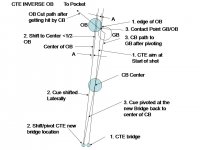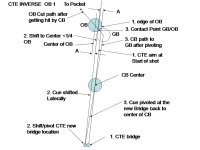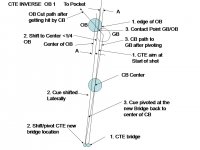CTE can be used effectively for a wide range of cut angles; however, if the
published procedures are followed exactly, without doing one or more of the four things suggested on my
evaluation page based on one's "visual intelligence" and/or "experience-based judgement" and/or "feel" or whatever else you want to call it, there is a large number of shots that will not be pocketed. This is an indisputable fact with any "aiming system" built on a
limited number of lines of aim (e.g.,
CTE,
fractional-ball aiming,
Hal Houle's 3-angle system,
SAM, etc.).
CTE has been around long before Stan came on the scene, and I have dedicated countless hours, over many, many years, with phone conversations, e-mail exchanges, and online forum discussions with many CTE proponents ... Hal, Spidey, and Stan included. I also very carefully reviewed and worked with Stan's DVD. I also worked with everything Hal and others shared with me over phone conversations and e-mail exchanges. It really bugs me when people imply I "haven't done my homework."
Neil, this is honestly ridiculous. The evaluation and analysis of CTE on my website is the result of my careful contemplation, analysis, and experiences. I worked very hard on these illustrations and explanations and I consider the page to be an objective and impartial evaluation, based on my opinions and understanding alone. Some of the "naysayers" might agree with parts of my analysis, but I certainly didn't create the resource based on anything any naysayer ever wrote or said.
Neil,
I respect your opinion and appreciate all of the contributions you have made to this forum over the years, but I wish you (and others CTE proponents) weren't so antagonistic toward me with this whole CTE thing. I've done my best to try to understand all perspectives on this issue for many, many years. I don't share your enthusiasm for the CTE approach (although, I do see many of the realistic benefits), but I don't appreciate you (and others) implying I haven't done my homework or that I have something against the people who have a vested interests in CTE. That is not the case. I have been a little harsh concerning some of the CTE "marketing" we have seen over the many years, but my opinions and evaluations have always been as objective and impartial as realistically possible. I have also always tried very hard to see all of the positives of all "aiming systems." Like you, if I think some technique or system can be helpful to people, I like to share it with enthusiasm. I am just not as enthusiastic about the CTE approach as you and some others are. But I certainly don't have anything personal against any of these people.
Respectfully,
Dave


